
On the Isla del Sol
Titicaca (or Titiqaqa in Quechua) is the largest lake in South America and, sitting at 3,812m, the highest navigable lake in the world. Coming here was one of the most anticipated parts of the trip for me, perhaps largely for what it represented. It straddles the border of Bolivia and Peru, at the top of the Altiplano, and sits at the heart of the historical cultures of the high Andes.
Rebecca here…
Tiwanaku
Our journey along Lake Titicaca actually started with an overnight trip out of La Paz to the ancient city ruins of Tiwanaku in early December 2015. Strictly speaking, Tiwanaku lies 20km from the eastern shore of the the lake and we didn’t see the lake itself during this trip, but the Tiwanaku culture is so strongly associated with the lake that it felt to us like the start of our time at Titicaca.

The modern town of Tiwanaku. The church is built with stones taken from the ruined ancient city.
The mechanic in La Paz had fitted new brake pads on the Yellow Van and said, as we left, go easy on them for a while until they settle in. How, we found ourselves wondering, do we go easy on brakes in the crazy traffic and steep hills of La Paz? (Of course, we use gears as much as possible to control our descents rather than brakes, but some use of brakes is necessary!) So, we decided, rather than go straight off to Coroico in the Yungas, as we had initially intended, which would mean almost immediately doing a long, steep descent of several 1,000s of metres through the mountains, we would go to somewhere up on the altiplano instead for our first drive with the new pads. So, a quick trip across the plain to Tiwanaku it was.

The old railway station

Women in their finest skirts buying blankets
We arrived in town at the end of the afternoon, planning to visit the historical site the next morning. During a short walk around the small modern, but poor, town, we were surprised to see lots of people dressed up in their finest and buying blankets and tea sets from temporary stalls on pretty much every corner. There also seemed to be a lot of parties just getting started, with doorways decorated with balloons and loud music emerging. When we asked at the hotel, we were told it was school graduation weekend, with graduation parties going on, at which it is traditional to give the graduate a blanket! Bruce was suffering a little with a stomach upset, which seemed to be something to do with the rabies vaccinations he had had to have in La Paz, so there was no gate crashing of graduation parties for us that night.

An artist’s impression of Tiwanaku at it’s peak

And, today, with the help of a little restoration
We first came across the Tiwanaku culture back in San Pedro de Atacama, before we began our Altiplano journeys (see our Atacama Desert blog here). At its peak, the civilisation had extended all the way south to there, the full length of the altiplano and around. We had been looking forward to seeing the site of the remains of their main city since we had enjoyed an episode of the BBC’s Lost Kingdoms of South America about the Tiwanaku.

The engineering is monumental, with stone blocks on the site that weigh up to 65 tons. How they were shaped remains a mystery, as they is no evidence of chisel marks. Some come from a quarry 50 miles away and would most probably have required huge communal efforts to transport them, as some recent archaeological experiments have demonstrated.

The large main platform
It is not thought to have been an aggressive culture, rather that it spread by trade and local adoption by neighbouring peoples. The Tiwanaku were great innovators in using irrigation and built complex systems that, as well as ensuring a steady water supply to fields, also captured the heat of the sun during the day to minimise cold damage at night. This provided a secure food supply in the harsh and unpredictable climate of the altiplano, hence their culture spread as people chose to become Tiwanaku and join the system.

The iconic sun gate
The geometric nature of the art is enchanting and the huge monoliths impressive (example below). A new museum has been built to house the best examples (no photos allowed, not that that always stops me!) and an older museum (no photography restrictions) showcases some of the fine pottery.

An owl monitors our progress around the site
The main temple site was built around 700AD, by which time the culture was already powerful, having emerged and spread over several centuries before that. It remained a powerful force across this part of the Andes for many centuries, then abruptly disappeared around 1200AD, most likely because of major climatic event, of the sort that has shaped the entire history of the peoples of the Andes.
Rock climbing at Peñas

Bruce being shown the way to the crag by two delightful dogs from the village
Bruce had been rather tantalised in La Paz when, during a short call at a tourist office, he had spotted a guidebook to climbing at Peñas, a place he had heard about, in a display cabinet. Not available for sale we were told, try this bookshop here (cross marked on city map). There we were told to try the next bookshop, and so on it went until we decided, after 2 or 3 bookshops, we weren’t really likely to find a copy. However, there was information to be found on the web (ask for the Priest at the church in the village, it said) and so we stopped on route at the small village of Peñas, which was just off the road between La Paz and the north shore of Lake Titicaca.
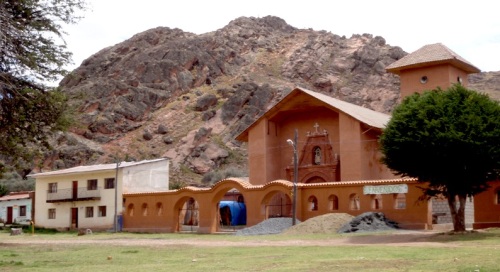
The church in the village of Peñas with a small section of developed crag behind

A memorial to Tupac Katari, who led an indigenous “Incan” uprising against the Spanish after more than two centuries of their rule in 1781 and succeeded in laying seige to La Paz for 184 days. He was eventually caught and killed in Peñas, but remains a folk hero.
It turns out there is a rather dynamic Priest of the church there who hosts backpackers to do volunteer work with local children. One of these volunteers, who has been working there for several years, has helped him develop rock climbing on the rather pretty crags behind the village. The longer term aim is to develop Peñas as a destination for climbers, with villagers offering accommodation a short distance from the serious mountaineering in the peaks around the edge of the plain and warm-up cragging behind the village.
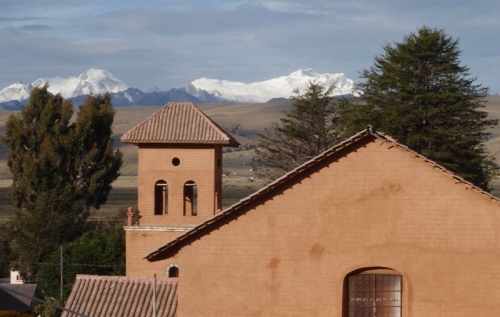
The Andean peaks across the plain from the village

One of the dogs that showed us the way to the crag kept our backs for much of the afternoon, until another, more interesting, group of climbers arrived!
We spent two enjoyable half days there, until rain dramatically stopped play (it’s suddenly very, very cold when it rains at 3,800m!) After a warming cup of tea with the volunteers at the church, we drove on to finally reach the lake itself, wondering when we would get the opportunity to dry the now soaking wet climbing kit filling the living space in the back of the van!
A Kon-Tiki expedition museum

A Titi is a large mountain cat and Heyerdahl decorated the prow of his experimental boat that he took around Lake Titicaca with a large cat’s head
Along the shore on the eastern corner of Lake Titicaca, we stopped at a museum all about Thor Heyerdahl’s famous the Kon-Tiki expedition. In 1947, he set off to cross the Pacific Ocean on a reed raft, aiming to prove that people from South America may have traversed the Pacific and made contact with Pacific cultures. We had come across his ideas during our visit to Easter Island a few months earlier (even we had noticed some apparent cultural connections), so it was interesting to learn more about it.
Heyerdahl had his reed boats made here, on the northern shore of the lake, because reed boats were still being made here for use on the lake using ancient techniques. It turns out that he rather started something with those expeditions and we learnt about the numerous more that have followed since and are still being made. The family that own the museum made several of the boats used in the various expeditions.

Reed boats on Lake Titicaca
On to Copacabana
The Lake has two sections, a smaller one to the east, which is where we first finally saw the lake itself coming from La Paz. This is separated from the larger part by a narrow channel between two peninsulas of land that almost reach each other across the middle. For reasons of complicated political history, the border between Peru and Bolivia crosses the lake at an awkward angle and slices across the larger, southern peninsula. This leaves the northern part of this peninsula as a small, somewhat remote pocket of Bolivia separated from the rest of the country by a narrow channel of water, across which small ferries ply.

Looking across between the two peninsulas dividing Lake Titicaca

On one of the simple ferries crossing the narrow channel between the two peninsulas
Copacabana (which is not to be confused with Copacabana beach in Rio de Janeiro!) is the Bolivian town on the lake shore of the peninsula, opposite the culturally important Isla del Sol, which is also in Bolivia.

This poor little boy, who can’t have been older that 7, lost his battle to keep hold of a pig that was considerably larger than he was. We were left hoping the pig had trotted home rather than being lost!
We were struck by the poverty we saw on this little outpost of Bolivia, despite it being a tourist destination and a popular weekend getaway for the rich of La Paz. Those not working in the tourist trade have a really hard existence eking out a living from the land. As we drove along the road, in what felt like a remote place, we passed several sets of small children with hands out begging to the occasional passing traffic. We had seen signs of extreme poverty in other parts of Bolivia, but not children earning their keep with hands out stretched at the side of the road. Children not begging were working, helping in the fields or tending animals, from a very early age.

All the hillsides around the lake are heavily terraced and it’s a hard life tending these fields by hand

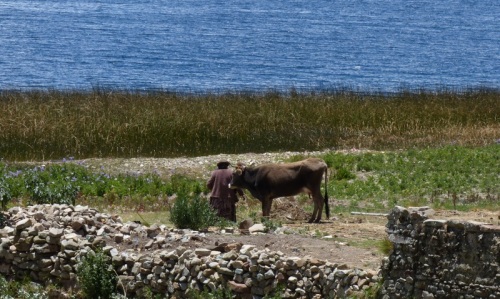
Copacabana itself has a resort feel to it, especially along its lakeshore front. It also offered a really quite comfortable little campsite in a pretty garden right on the lakeside. This was all quite welcome to us, after the hectic chaos of La Paz, and we rather wished we had a little more time to stop and relax there, but we only had a few days left on our visas for Bolivia and we wanted to get on to Cusco for Christmas.

Copacabana lake front

A group effort to get a new boat launched on Copacabana’s shores
There’s a rather unusual tradition in Copacabana to decorate vehicles and get them blessed in front of the cathedral. A collection of stalls in front of the lovely white cathedral building sells beautiful flowers and other trimmings. We thought about getting the Yellow Van blessed, but it didn’t seem sensible to decorate the van in flowers when the next stop would be the Peruvian border!
The Isla del Sol
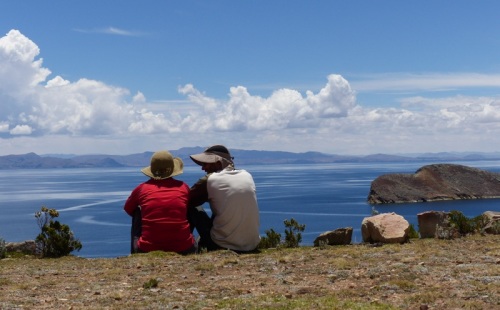
On the Isla del Sol

This unsuspecting passenger on our little speed boat ended up driving while our boatman tried to (unsuccessfully) fix his second motor. With only one motor, our journey was a little longer than it should have been!
From Copacabana, little speed-boats run across the lake to the legendary Isla del Sol. We took one to the furthest end of the island, where, when we landed, we were rather herded, as a flock of tourists, through the village to buy a visitor’s tickets, which rather took the magic away!
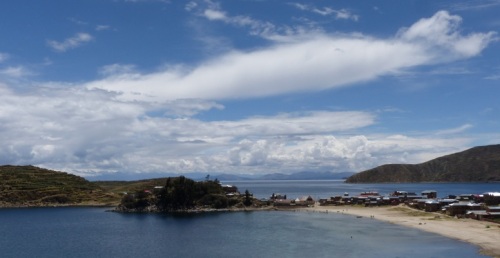
Challapampa, at the north-west end of the Isla del Sol
The island has had an important place in the mythology of many of the historical cultures that have come and gone in the high Andes. Most recently, for the Incas, it was the location of their creation myth. They believed that, when the earth was in darkness, the god Viracocha emerged from the lake, bringing some humans with him. He then created the sun, the moon and the stars to light the world. It is a short walk from the village to see the rock and altar that was revered as the site of this event (the sun was said to have been pulled from the rock, which faces east), with ruins of a labyrinth next to it.

Walking across to the Sacred Rock

The Sacred Rock and altar – the site of the Incan origin myth

Exploring the ruins of the labyrinth next to it
From there, we set out to walk the length of the small island, thankfully leaving most of the other tourists behind to get back on a boat. A well-maintained path follows the top of the hills along the island’s spine.

A well laid path runs the length of the spine of the island

The Andean peaks visible in amongst the cloud to the north

At the south eastern tip of the island…

… looking back towards Copacabana
It was a delightful walk, taking us to Yumani, the largest village on the island. We checked into a hostel for the night and continued on to the island’s tip, before coming back to the village to relax with a beer.

Relaxing at the end of the day with a beer and a good view
There is something magical about Lake Titicaca here. Perhaps it is the combination of the thinness of the air at that altitude, which makes the colours brighter and lighter somehow, with the serenity of the huge, still lake. We could see why this island, along with the smaller Isla de Luna nearby, had taken on religious significance for the various pre-Columbian cultures.


The Horca del Inca – which isn’t…
 On our last morning in Copacabana and, indeed, Bolvia, we took the time, despite some rain, to climb up out of the town to the “Horca del Inca”, which turns out not to be either a Horca (which means gallows), nor Incan. It’s actually a pre-Incan site that was thought to have been used to measure the seasons of the year. Originally there would have been a whole series of standing stones with cross stones, like the one to the right, which religious officials would have used to measure the sun rise and set and the stars. The Spanish conquistadors assumed it was Incan and, finding no gold, largely destroyed the structure.
On our last morning in Copacabana and, indeed, Bolvia, we took the time, despite some rain, to climb up out of the town to the “Horca del Inca”, which turns out not to be either a Horca (which means gallows), nor Incan. It’s actually a pre-Incan site that was thought to have been used to measure the seasons of the year. Originally there would have been a whole series of standing stones with cross stones, like the one to the right, which religious officials would have used to measure the sun rise and set and the stars. The Spanish conquistadors assumed it was Incan and, finding no gold, largely destroyed the structure.

Climbing the carved stone staircase to the so-called Horca
And on into Peru, country number six

Obligatory picture of cute Alpacas!
Apart from nearly getting caught behind a series of buses full of backpackers, the main traffic at this little border, the crossing from Bolivia into Peru was simple and friendly and aided by the Bolivian customs official who quickly took our Bolivian TIP (Temporary Import Permit for the van) and waved us through the barrier to allow us to get through to Peru Immigration ahead of the buses! Thank you nice Bolivian Aduana official with no uniform!
The Peruvian Aduana official (customs) took a close look at our liability insurance policy for the van for Peru, which we had been able to buy in La Paz (although at much greater cost than buying it locally). We had been pre-warned about this. At most borders into Peru, you can buy the required basic policy at the border, but not at this little one near Copacabana. People who drive on without it to the nearest town frequently find themselves being stopped at a police checkpoint on route and asked to show their insurance policy, which requires a little wriggling to get out of. We were pleased we had spent the extra to buy it in Bolivia before entering Peru.

A pig enjoying its muddy spot on the lake shore
Later on, we were also pleased that we had followed the advice of those that had gone before us and got the Aduana to add permission for tinted windows to our Peruvian TIP, as a favourite concern of police in Peru is that a permit is required for vehicles to have tinted windows, which, of course, foreigners can’t get – another potential cause for some wriggling. When we were stopped (which we were several times while in Peru) and asked about our tinted window permit, we were able to show (a copy of) our TIP, with permission for tinted windows on it. Yet again, we gave thanks to the modern world of the internet where such knowledge can be so easily shared.

Our first stop in Peru was the small Templo de Fertilidad, which, inside, was full of quite obvious symbolic structures!
The floating islands of the Uros
 Having driven up the south-western shore of the lake, on the Peruvian side, we hit Puno, our first Peruvian city, near the western corner of the lake, just as an enormous storm hit. We drove through town, which began to feel like an extension to the lake as sheets of rain pounded down around us, with lightening striking repeatedly, it felt, unnervingly close by. We had intended to find a secure car park in the city centre and a cheap hostel bed for the night, but we couldn’t find the promised car park and could hardly see a thing…
Having driven up the south-western shore of the lake, on the Peruvian side, we hit Puno, our first Peruvian city, near the western corner of the lake, just as an enormous storm hit. We drove through town, which began to feel like an extension to the lake as sheets of rain pounded down around us, with lightening striking repeatedly, it felt, unnervingly close by. We had intended to find a secure car park in the city centre and a cheap hostel bed for the night, but we couldn’t find the promised car park and could hardly see a thing…

Parked at the Hotel Libertador, set on its own peninsula opposite Puno
So, we succumbed to temptation and, for the first time on the trip (remarkable really), we drove out to a little peninsula on the lake shore to a 5* hotel and, after a little negotiation to make a big difference to stated price (it was pretty empty), we checked in. And what a treat it was – spa facilities to cheer us up after the rain and a wonderful restaurant. It was really a rather nice way to start our time in Peru and the best way to try cuy (guinea pig) for the first time!
 The reason for staying in Puno at all (despite some vehicle security concerns, which we avoided by checking into a posh hotel), was to visit the floating reed islands of Urcos. This part of the lake is thick with reeds and, some centuries ago, supposedly to escape the encroachment of the Incas, the Uros people moved out onto the lake and started living on floating islands made of reeds.
The reason for staying in Puno at all (despite some vehicle security concerns, which we avoided by checking into a posh hotel), was to visit the floating reed islands of Urcos. This part of the lake is thick with reeds and, some centuries ago, supposedly to escape the encroachment of the Incas, the Uros people moved out onto the lake and started living on floating islands made of reeds.

Watching the tourist boats travel out to the islands from our breakfast table

The extensive floating town of the Uros, out on the lake opposite Puno

Arriving to visit an island
On the road, we had met quite a few people who had decided not to make this trip. The only way to see the islands is on a tour out of Puno (or in our case, on a tour boat that stopped to pick us up from the private jetty of our hotel!) and, of course, it’s not “genuine” anymore and it feels very “touristy”. But, to us, it is a living museum. It is not a comfortable and healthy way to live and, thankfully, most of the Uros now live on land. Yet they want to maintain their history and culture and welcoming tourists to visit is a way to make that possible. We were happy to play along and the emerging anthropologists in us were fascinated to see how a whole people could have lived in such a way for centuries.
Here is a gallery of images from our morning on the islands. Click on a picture to open the gallery and read the captions to learn a little more about them, then scroll down to read on.
Onwards towards Cusco

Ugly reflective stickers in an effort to remove a reason for the Peruvian police to pull us over
After our insight into floating island life, on 22 December 2015 we left Lake Titicaca behind us, pausing only to decorate the van with some rather ugly reflective stickers (another favourite of the Peruvian police, we had heard), and we headed onwards towards Cusco.
Christmas preparations began when we stopped at a cheese factory by the road and bought a big round cheese. All across South America so far, we had been surprised that, despite having a strong beef and diary industry, there is little in the way of a cheese culture. On one occasion, we had overheard a local guide not being able to explain why to his visiting clients. All the local cheese is really very similar – crude and very salty.
But there are subtle variations between them when you get into it and we were relieved to find that this one we had bought, without being offered a taste, was one of the nicest we’d had.

Tucked into a lovely overnight spot by a small museum in the pretty, even in the rain, Tinagani Canyon
We climbed up out of the northern end of the Altiplano, which we had enjoyed so much, and over a high, snowy pass into strikingly lush, rich farmland. No wonder the Incans decided to call these valleys home – but that’s for the next instalment.
































Enjoyed your story. Thanks for sharing. We also love the Lake Titicaca region. Will you drive to Machu Picchu (Santa Theresa)?
LikeLike
Hi Karin, glad you enjoyed our write up. Our blog posting is a little behind I’m afraid – we were in Cusco for Christmas. We did go to Machu Picchu, but we took the train from Ollantaytambo. We went in January, in the rainy season, and we heard the road to Santa Theresa wasn’t really drive-able then. But we were always going to do the train ride anyway because my father talks about it from when he did it 50 years ago. He travelled all over the world chasing interesting trains and doing the world’s best railway journeys. Of course, it was quite different then (Aguas Calientes barely existed and he persuaded someone with a horse and cart to give him a ride up to MP when he stepped off the train!), but having heard about these journeys all my life, I really wanted to do the train journey.
LikeLike
Ole! 3 posts in one week all enjoyed and loving your travel pics. We believe Paula & Jeremy Dear are now back in UK and invited them for brunch at The Ivy Cafe as lots to discuss before we head off ourselves. Friends from Cambridge have gone East in a 4×4 Synchro safely through all the Stans & Mongolia & China currently in Cambodia and are having a BIG adventure so maybe we should forget Panam in a van and instead go overland across Asia which is an interesting option but more hardcore! Might have asked before but did you ever bump into Manuel & Jill in their T4 Red Burrito? Buen viaje!
LikeLike
I wonder if it is possible to ask some questions about how you brought your van into Montevideo?
We are arriving mid September and enjoy reading your blog immensely.
LikeLike
Hi Anne, always happy to help if we can. Perhaps you haven’t seen my reply to your previous comment? I’ll drop you an email to connect.
LikeLike